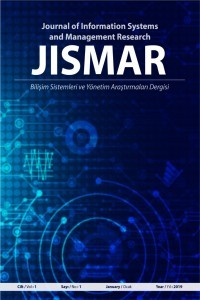Yapay Zekâ Yöntemlerinde Entropi
Bilginin Düzensizliği, Entropi, Yapay Zekâ
Entropy in Artificial Intelligence Methods
Disorder of Information, Entropy, Artificial Intelligence,
___
- [1] R. Clausius, "Über verschiedene für die Anwendung bequeme Formen der Hauptgleichungen der mechanischen Wärmetheorie," Annalen der Physik, vol. 201, pp. 353-400, 1865.
- [2] M. Badino, "Mechanistic slumber vs. statistical insomnia: the early history of Boltzmann’s H-theorem (1868–1877)," The European Physical Journal H, vol. 36, pp. 353-378, 2011.
- [3] J. W. Gibbs, On the equilibrium of heterogeneous substances, 1879.
- [4] H. Nyquist, "Certain factors affecting telegraph speed," Transactions of the American Institute of Electrical Engineers, vol. 43, pp. 412-422, 1924.
- [5] R. V. Hartley, "Transmission of information 1," Bell System technical journal, vol. 7, pp. 535-563, 1928.
- [6] C. E. Shannon, "A mathematical theory of communication," Bell system technical journal, vol. 27, pp. 379-423, 1948.
- [7] C. E. Shannon, "Axiomatic derivation of the principle of maximum entropy and the principle of minimum cross-entropy," IEEE Transactions on information theory, vol. 26, pp. 26-37, 1948.
- [8] S. F. Gull, "Bayesian inductive inference and maximum entropy," in Maximum-entropy and Bayesian methods in science and engineering, ed: Springer, 1988, pp. 53-74.
- [9] B. Hssina, A. Merbouha, H. Ezzikouri, and M. Erritali, "A comparative study of decision tree ID3 and C4. 5," International Journal of Advanced Computer Science and Applications, vol. 4, 2014.
- [10] A. Janecek, W. Gansterer, M. Demel, and G. Ecker, "On the relationship between feature selection and classification accuracy," in New Challenges for Feature Selection in Data Mining and Knowledge Discovery, 2008, pp. 90-105.
- [11] N. Murata, S. Yoshizawa, and S.-i. Amari, "Network information criterion-determining the number of hidden units for an artificial neural network model," IEEE Transactions on Neural Networks, vol. 5, pp. 865-872, 1994.
- [12] C.-Y. J. Peng, K. L. Lee, and G. M. Ingersoll, "An introduction to logistic regression analysis and reporting," The journal of educational research, vol. 96, pp. 3-14, 2002.
- [13] C. Liu and H.-Y. Shum, "Kullback-leibler boosting," in Computer Vision and Pattern Recognition, 2003. Proceedings. 2003 IEEE Computer Society Conference on, 2003, pp. I-I.
- [14] R. Jenssen, K. Hild, D. Erdogmus, J. C. Principe, and T. Eltoft, "Clustering using Renyi's entropy," in Neural Networks, 2003. Proceedings of the International Joint Conference on, 2003, pp. 523-528.
- [15] R.-P. Li and M. Mukaidono, "A maximum-entropy approach to fuzzy clustering," in Fuzzy Systems, 1995. International Joint Conference of the Fourth IEEE International Conference on Fuzzy Systems and The Second International Fuzzy Engineering Symposium., Proceedings of 1995 IEEE Int, 1995, pp. 2227-2232.
- [16] C. Jin, L. De-Lin, and M. Fen-Xiang, "An improved ID3 decision tree algorithm," in Computer Science & Education, 2009. ICCSE'09. 4th International Conference on, 2009, pp. 127-130.
- [17] C.-L. Chang and M.-Y. Hsu, "The study that applies artificial intelligence and logistic regression for assistance in differential diagnostic of pancreatic cancer," Expert Systems with Applications, vol. 36, pp. 10663-10672, 2009.
- [18] G. Li and J. Shi, "On comparing three artificial neural networks for wind speed forecasting," Applied Energy, vol. 87, pp. 2313-2320, 2010.
- [19] D. Yu, K. Yao, H. Su, G. Li, and F. Seide, "KL-divergence regularized deep neural network adaptation for improved large vocabulary speech recognition," in Acoustics, Speech and Signal Processing (ICASSP), 2013 IEEE International Conference on, 2013, pp. 7893-7897.
- ISSN: 2717-9931
- Yayın Aralığı: Yılda 2 Sayı
- Başlangıç: 2019
- Yayıncı: M. Hanefi CALP
Blockchain Tabanlı Bir Veri Yönetim Modeli
Mohammed ALSADİ, Sevinç GÜLSEÇEN, Sinan KARA, Büşra ÖZDENİZCİ KÖSE, Vedat COŞKUN
Yapay Zekâ Yöntemlerinde Entropi
Muhammed Ali KOŞAN, Aysun COŞKUN, Hacer KARACAN
Yapay Zeka ile Siber Zorbalık Eğiliminin Belirlenmesi
Makine Öğrenmesinde Yeni Bir Bakış Açısı: Otomatik Makine Öğrenmesi (AutoML)
Ders Programı Çizelgeleme Probleminin Genetik Algoritma ile Optimizasyonu
Web Analitiğinde Sosyal Medya Kullanımı
Reyhan BAŞBAYRAM, İbrahim Burak TOSUN, Aykut Hamit TURAN
Yazılım Hata Kestirimine Nesne Yönelimli Ölçütlerin Etkisi
Tülin ERÇELEBİ AYYILDIZ, Begüm ERKAL
Smart City Applications In Digital Age: State-Of-Art Review and Critique
Sadakat Programında Müşteri Kayıp Tahmini: Bir Vaka Çalışması
Yeşim KOCA, Burak Emre SÖĞÜT, Sona MARDİKYAN
Yeni Dünya Düzeninde Öğrenen Örgütler, Değişim ve İnovasyon Yönetimi
